 |
 |

|
 |

|
A Hungarian NOHAB in Denmark – Odense, August 14–15, 2004
|
 |
 |
 |
 |
 |
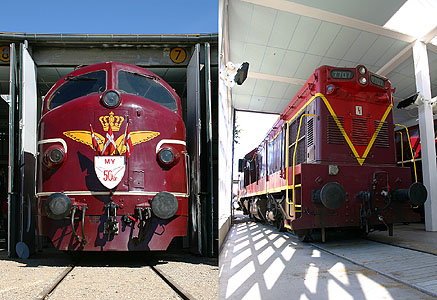 In 2004, fans of NOHAB locomotives can celebrate several noteworthy anniversaries. 65 years ago, in November 1939, the distant ancestor of the NOHAB's, the first string of FT series locomotives started its demonstration tour in America. 50 years ago, in 1954, it was Europe who witnessed two events worth remembering. One was the introduction of the G12 export model demonstrator of General Motors whose test runs resulted, for example, in the Austrian Federal Railways (ÖBB) ordering EMD-powered locomotives. Also in the same year, the first NOHAB-built diesel-electric locomotive with a prime mover and a power transmission by EMD, MY1101, entered service at the Danish State Railways (DSB).
The Danish Railway Museum (Danmarks Jernbanemuseum) envisaged to commemorate the latter two events in a way the world-famous GM-locomotives deserve – with an international meeting featuring museum locomotives of the original operators of NOHAB's roundnoses and their relatives – i.e., five state railways – and GM-powered machines of private railways and preservation groups. |
 |
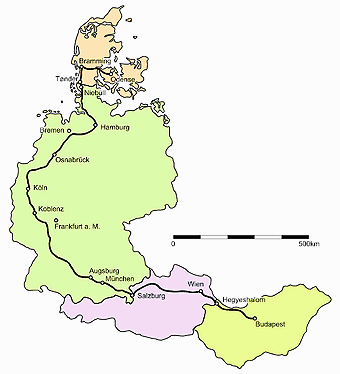 The museum contacted our foundation concerning the participation of a Hungarian NOHAB locomotive and invited our machine, former M61-010, to take part in the event. However, our locomotive having not acquired a running license yet, we agreed on organizing the visit of another member of the class to Denmark. Currently, only former M61-017 (now 2761 017-9) is in a service condition under which such a long journey could be carried out with full responsibility, therefore, it was clear from the start that the visit of the locomotive will be carried out in cooperation with its current owner, the MÁV Directorate of Track and Structures (PMLI). Several obstacles hindered the organizing work which were finally all overcome with the help of Dr. Tibor Zsákai, former director general of MÁV PMLI, Dr. László Mosóczi, current director general of MÁV PMLI and Dr. József Csiba, director general of the Mechanical Branch of MÁV Co. – we would like to express our gratitude again for their substantial help. Also, we would like to thank traction manager Miklós Onódy, as well as locomotive engineers Csaba Büki and Imre Korom for taking part in the special run.
As for the route of the journey, two basic alternatives were taken into consideration. The cheaper solution would have run through Slovakia, the Czech Republic and Poland with the locomotive traveling under its own power and finally a short piece through Germany where another locomotive, equipped with Indusi signalling as required, would have hauled the consist. Travelling directly through Austria and Germany is shorter, however, much higher track usage and traction costs should be expected. Eventually, the cheaper alternative had to be abandoned as there was not enough time left for the acquisition of the operating licenses in the Eastern European countries concerned. The costs of the more expensive version, chosen out of necessity, were covered by the organizer of the event, Danmarks Jernbanemuseum, and a famous German enthusiast of NOHAB's, Klaus Korbacher – again, we thank for their huge support! Also, we would like to thank the crew accompanying the machines from Luxembourg – especially Marcel Barthel – for hauling us free of charge between Koblenz and Tønder. In the week prior to the meeting, the final route of our journey was settled: Budapest – Hegyeshalom – Wien – Salzburg – München – Augsburg – Koblenz – Köln – Osnabrück – Hamburg – Niebüll – Tønder – Bramming – Odense. |
 |
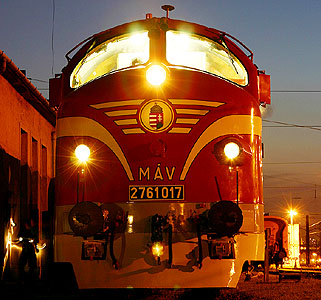 The special run, consisting of locomotive 2761 017-9 and a couchette car for the accompanying crew, started at 9 in the evening on August 10, 2004, in Budapest-Józsefváros. We spent the night in Hegyeshalom, continuing the journey the next morning, accompanied by an Austrian piloting crew but still under our own power, via Salzburg to the German border. To allow our passing through Austria without the local standard of signal reception device, a specific permit was issued by the Austrian rail authority ÖBB Netz.
In Germany, the rules are more strict and lacking the required signal reception devices, we had to be piloted by another locomotive. Starting at the border station Freilassing, we were hauled by the motive power of a German private railway, BBG Stauden, a unit formerly belonging to ÖBB's 2143 class. Passing through München, we arrived at Augsburg for a refueling stop, then continued the journey to Koblenz where we arrived late at night on August 11. |
 |
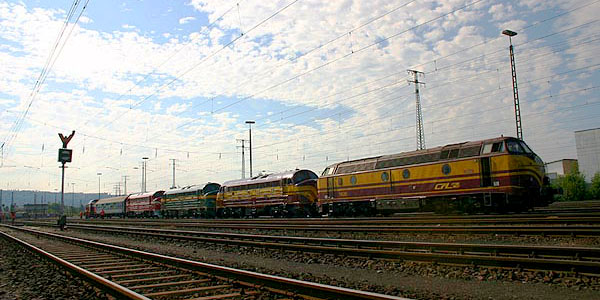 On August 12, we joined a light engine run of three more GM-powered locomotives also bound for the event in Odense. The locomotive of the Belgian preservation group PFT (Patrimoine Ferroviaire Touristique), built under NOHAB's license by AFB, is currently numbered 202.020 and wears an older livery of the Belgian State Railways (SNCB). In its years of regular service, the unit was 1602 of the Luxembourg State Railways (CFL), however, the Belgian livery still corresponds to history in the sense that the Luxembourg roundnoses of the 1600 class were originally built for Belgium and were handed over to CFL according to a special agreement. Luxembourg was also represented by a roundnose: 1604, maintained in assignment of the Luxembourg Office for Heritage Preservation by 1604 Classics a.s.b.l. Luxembourg, and the consist was hauled by another machine of CFL, 1805, which is equipped with the Indusi signal reception device as required in Germany. The 1800 class of Luxembourg also sports a GM prime mover (they were built by AFB's successor La Brugeoise et Nivelles) and, despite their more angular appearance, have mechanically much in common with the NOHAB's; even their age is comparable to that of the Hungarian M61's.
One more locomotive was temporarily added to the consist of one car and four GM-powered machines: a survivor of the former East-German V100/V110 class, now in regular service for NEG (Norddeutsche Eisenbahngesellschaft), a subsidiary of CFL. The distance mastered on August 12 was relatively short as after leaving the Rhine valley, the adverse weather imposed a serious hindrance on further advance. At Hilden near Köln we stopped for the rest of the day: due to the storms, rail traffic was suspended on several lines. |
 |
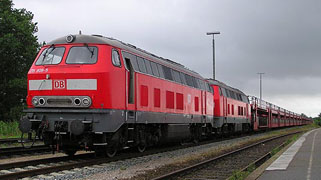 Next day, the journey went on to Niebüll. Aside from being the home base of NEG, this town is also known as the starting point of the “Autotrains” to the island Sylt which is only connected to the continent by rail, offering this indirect way of transporting road vehicles to the island.
From Niebüll, we were bound for the Danish border station Tønder, using a branch line which is most of the time only served by railbuses. We had to slow down while traversing stations: the platform edges, built for the tighter clearance of the railcars, could only be passed with special care. |
 |
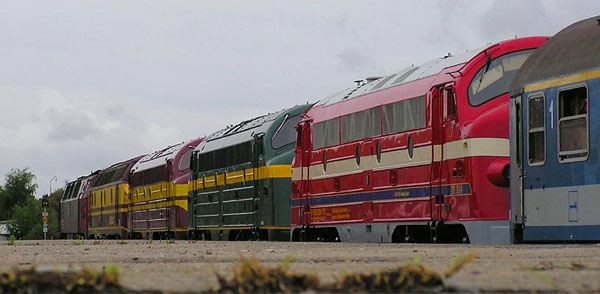 In Tønder, a fifth piloting locomotive joined the other four: the first member of DSB's MZ series, 1401, also a NOHAB-GM. From here, the trip went on to Bramming and finally to Odense, where we arrived late in the night, several hours later than expected. Despite the delay, a huge mass of people was waiting for the special run and soon, it turned out that all were already informed of all important events of the journey. Obviously, railway enthusiasts and photographers were excellently passing information to each other. |
 |
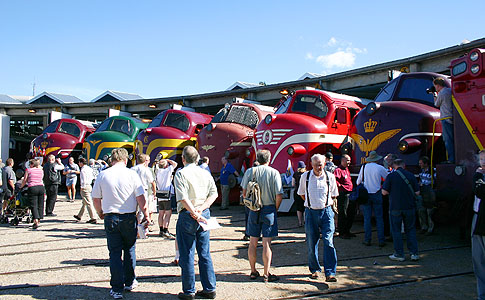 The two days of the GM meeting, August 14 and 15, left a positive impression as well. The event featured nearly twenty GM-powered guest locomotives, motive power of private railways as well as museum machines along with the celebrated MY1101. Most of them represented the original NOHAB “roundnoses” in both the 12 and the 16-cylinder version, as well as their AFB-built copies produced under NOHAB's license. It was striking, at least for those accustomed to Eastern European practices, that quite a large share of the museum locomotives is owned or maintained by railway enthusiast groups. An example could be the other celebrated machine, former G12 demonstrator 7707, owned by GM-Gruppen of Norway. The latter locomotive differs much from the roundnoses, its hood design is rather reminiscent of its more common 16-567-powered relatives of the G16 series, known as “Kennedy” in former Yugoslavia or “Americana” in Spain. A similar hood design is apparent in the Swedish T41 class, powered by a 12-cylinder prime mover, represented by two units at the meeting. Also, more angular types could be seen: aside from the 16-567-powered 1805 of Luxembourg, built by BN, two turbocharged 16-645-powered Danish MZ class locomotives attended the event, as did one more MZ powered with a supercharged 20-645 engine, all latter three built by NOHAB. Occasionally, also a Henschel-built unit of the Danish ME class, equipped with a turbocharged 16-645, joined the show. |
 |
 During the event, each locomotive was presented on the turntable of the museum, and between the shows, the visitors could take a closer look at the machines in the roundhouse. Between Odense and some nearby stations, a few special runs were also arranged with the guest locomotives, among them the NOHAB from Hungary which could be seen hauling a set of Danish museum cars. The number of visitors (seven thousand during the two days of the event) and the huge queue in front of the museum building were impressive, as was the fact that the disciplined visitors never hindered the movement of the locomotives, be it at the turntable or at the platform of the special runs – just as local railway enthusiasts respected each other while taking photos.
Also, the high standards of the museum exhibits are worth mentioning, considering their aesthetical arrangement as well as their actual contents. Aside from the painstakingly restored vehicles, the detailed models and the clean environment, we were also surprised by the impressive lot of other equipment on display, explaining the operation of the railroad. Some historic details were highlighted by special exhibits or video presentations – so we could learn how technical documentation was protected from the bomb attacks of World War II, or we could see other means of transportation (ferries, buses) operated by DSB. |
 |
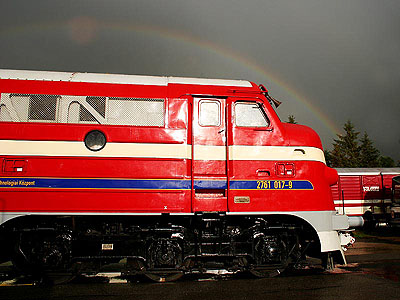 In the evening of August 15, preparations were met to conclude the meeting: some locomotives departed for their home. These machines joined a regular passenger train, so that a somewhat unusual consist was formed: led by a control car and a number of passenger cars, an ME class machine followed, trailed by four guest locomotives and a set of museum cars at the end. The machines from Sweden and Norway departed on the next morning with a not less spectacular train, and finally, the locomotives from Hungary, Belgium and Luxembourg left Odense as well, again, piloted by MZ 1401. This time, a Danish track measuring car and another crew car was added to the consist at Kolding.
On August 16, the day's journey ended at Niebüll. Here, in the locomotive shed of NEG, the three “roundnoses” – 2761 017-9, 202.020 and 1604 – could be photographed again. The rainbow, adorning the silhouette of 017 for some seconds, was a fitting recompense for the heavy rain which vainly tried to scare away the photographers. At the end of the day, the Luxembourgian 1805 hauled the track measuring car – along with the Danish and Hungarian accompanying cars – to the pier near Dagebüll where the train spent the night before joining the three “roundnoses” the next morning at Niebüll. |
 |
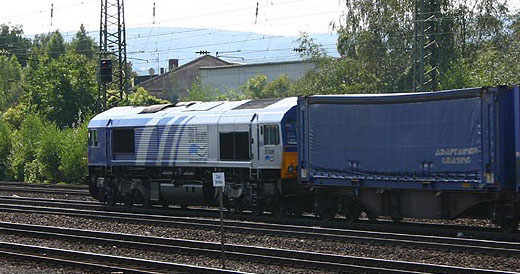 In the evening of August 17, we arrived at Koblenz where the Belgian 202.020 and the two Luxembourgian locomotives parted with us, returning home. The 2143 series locomotive of the Staudenbahn, meant to haul us to the Austrian border, was only scheduled to arrive the next evening, so on the 18th, we had almost a whole day of spare time for paying a visit to the town and the local DB-Museum. The collection of the latter consists to the greater part of famous vintage electrics (E60, E44, E16, E18, E41, and a 103 which was then away hauling a special run, and others), extended by some cars, a diesel switcher and a steam locomotive currently undergoing restoration. As our hosts reported, the DB-Museum at Koblenz is financially less favored than the large central collection at Nürnbeg, but still, they regard their locomotives as their own treasures worth caring for.
As it could be seen, traditions are well maintained in Koblenz, yet the present-day railroads of the area are also of interest for the enthusiasts of GM-powered locomotives. Several times a day, JT42 export machines, also named “Class 66” after their British classification, can be seen on various freight duties. |
 |
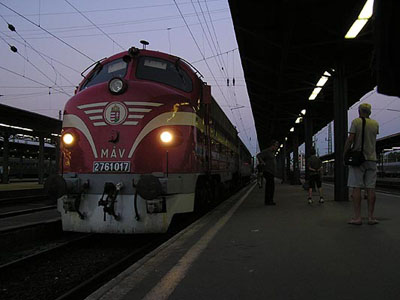 The most critical hours of the journey came in the night of August 18. The sky was clear all day, yet this was only a deceptive prelude to a massive bulk of clouds and heavy rainstorms, claiming the power inverter of a nose light in the 017 for a victim. This time, we arrived Augsburg on a different route, leading over a neglected track whose overgrown vegetation left its permanent scars on the 017 and the piloting locomotive. Unfortunately, one can indeed find many similarly derelict tracks across the dense rail network of Germany. This is even more striking compared to the situation in Austria where rebuilding or new construction are the most common sight along the tracks; even the minor industrial lines would hardly be cut back.
On August 19, the journey went on in Austria again where the Hungarian locomotive could move under its own power by special permission. By the afternoon, we reached Hungary where fast proceeding was rarely the case. Sometimes, track reconstruction sites held us back, on other occasions, our train was delayed without any apparent reason, though the evening before national holidays can bring very heavy traffic indeed. The daylight already began to dim when our special run, held back for hours at Ferencváros, arrived at track 10 of Budapest Keleti pu., concluding the memorable journey of 2761 017-9, former M61-017. |
— Back —
|

|
|